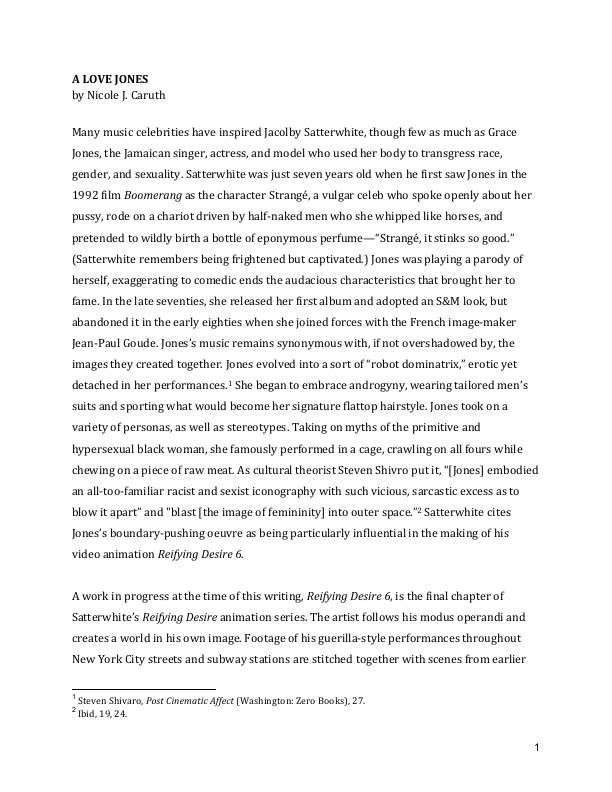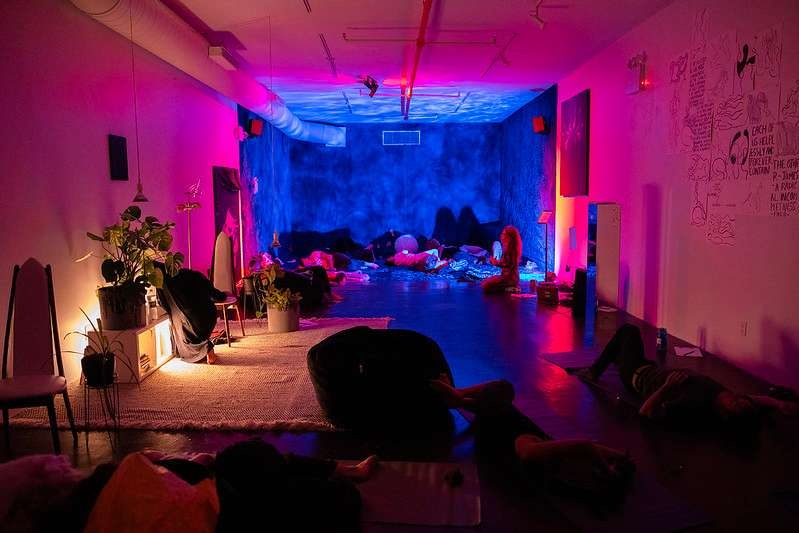Many music celebrities have inspired Jacolby Satterwhite, though few as much as Grace Jones, the Jamaican singer, actress, and model who used her body to transgress race, gender, and sexuality. Satterwhite was just seven years old when he first saw Jones in the 1992 film Boomerang as the character Strangé, a vulgar celeb who spoke openly about her pussy, rode on a chariot driven by half-naked men who she whipped like horses, and pretended to wildly birth a bottle of eponymous perfume—“Strangé, it stinks so good.” (Satterwhite remembers being frightened but captivated.) Jones was playing a parody of herself, exaggerating to comedic ends the audacious characteristics that brought her to fame. In the late seventies, she released her first album and adopted an S&M look, but abandoned it in the early eighties when she joined forces with the French image-maker Jean-Paul Goude. Jones’s music remains synonymous with, if not overshadowed by, the images they created together. Jones evolved into a sort of “robot dominatrix,” erotic yet detached in her performances.[1] She began to embrace androgyny, wearing tailored men’s suits and sporting what would become her signature flattop hairstyle. Jones took on a variety of personas, as well as stereotypes. Taking on myths of the primitive and hypersexual black woman, she famously performed in a cage, crawling on all fours while chewing on a piece of raw meat. As cultural theorist Steven Shivro put it, “[Jones] embodied an all-too-familiar racist and sexist iconography with such vicious, sarcastic excess as to blow it apart” and “blast [the image of femininity] into outer space.”[2] Satterwhite cites Jones’s boundary-pushing oeuvre as being particularly influential in the making of his video animation Reifying Desire 6.
A work in progress at the time of this writing, Reifying Desire 6, is the final chapter of Satterwhite’s Reifying Desire animation series. The artist follows his modus operandi and creates a world in his own image. Footage of his guerilla-style performances throughout New York City streets and subway stations are stitched together with scenes from earlier chapters of Reifying Desire where the artist vogues in a tree-lined creek in upstate New York and in the sand along the California coastline. To these landscapes, he has added subway trains, gardens, celestial bodies, and floating objects, ultimately forming a new city, a mythological landscape—his version of the Garden of Eden. Here, orifices function as doorways from one magnificently strange space into another one. Satterwhite’s “vagina”—as he calls the leather-harnessed iPod strapped to his crotch during public performances—is the primary portal.[3] From here, the viewer arrives at a pink architectural structure reminiscent of Frank Lloyd Wright’s Guggenheim museum. Like something out of a science fiction film, legions of dancing Jacolbies populate every level of the building. And then a lone Jacolby appears on the ground outside of the structure, leaning back on the palms of his hands and moving his legs together in a Thighmaster-like motion. He squeezes out a fetus, beginning to birth his own “nation.”
Like Ridley Scott’s film Prometheus, Reifying Desire 6 is an elaborate science fictional prequel that reveals the bizarre genesis of Satterwhite’s main character: himself. As in all other chapters, his three-dimensional renderings of his mother’s drawings (a means of coping with her ongoing schizophrenia) are the architecture of this futuristic setting). In this story of pleasure and procreation, the artist has cast himself as female, mother, and matriarch, and applied concepts of bareback breeding to explain the paternity of his children. Bareback, which means to ride a horse without a saddle, is code among gay men for intentionally unprotected anal sex between two men in which the top “breeds” the bottom by ejaculating inside of him. Because bareback culture employs metaphors of insemination, pregnancy, and kinship[4] it offered Satterwhite a framework to explore “birthing new possibilities” in his work—“new concepts, ideas, and people,” symbolized by eggs, fetuses, umbilical cords, and the exchange of bodily fluids.
Reifying Desire 6 marks a shift in this series of animations: this is the first time that a body other than Satterwhite’s enters the picture. Cast in the role of breeder, or the father of all Jacolbies, is the bareback porn star Antonio Biaggi, who the artist describes as “a superhero.” In the artist’s temporary studio at Recess, the men filmed a mock but convincing green screen sexscapade. “Grace Jones and her white men” inspired their video shoot. (As an example, Satterwhite mentions the well-known Playboy spread of Jones with former boyfriend and Hollywood action hero Dolph Lundgren.[5]) In Reifying Desire 6, viewers see footage of the artist and Biaggi collaged into imaginary environs, such as in a “breeding garden” or floating on top of levitating platforms, suggesting orgasmic ascent. Satterwhite clings to Biaggi’s limbs, lays prostrate on top of him, and tosses his legs overhead in submission. “Hyper-sexualizing and choosing to subjugate my own body is where Grace Jones comes into my work,” Satterwhite explains. Wearing only his vagina and strap-on “breasts,” the artist has abandoned his usual spandex costume, shedding his second skin as it were, and in so doing personifies barebacking—the vulnerability of the body not mitigated by contraceptive.
Satterwhite’s portrayal also signifies the shift in political and psychological attitudes towards barebacking that’s taken place since Jones’s heyday. The apex of Jones fame coincided with the rise of the AIDS epidemic, when “organized sexual risk,” or intentional unprotected sex, would have been considered unthinkably reckless and tantamount to a death sentence.[6] Subsequent safe sex education campaigns set the tone for generations, but Biaggi, an icon of bareback porn, is, as Satterwhite says, “fearless, unafraid of nineties politics” and thus represents a refusal of social norms. For Biaggi’s generation, the availability of antiretroviral medications has changed what it means to live with HIV, though, as the queer philosopher, Tim Dean warns, “It would be a mistake to say, “the drugs ‘caused’ barebacking.”[7] And yet barebacking subculture, which privileges erotic fantasy and pleasure over contraception, does suggest that HIV now carries little or less consequence. Furthermore, as Dean has found in his research, some barebackers want to be “inseminated” with HIV.[8] They do not see this as a destructive but as a procreative action that is believed to form a consanguineous bond when the virus is passed on, or replicated in another body. Satterwhite is uninterested in making moral judgments here, focusing instead on fundamental concepts, such as this idea of replication, of a queer lineage made up of copies.
Satterwhite’s brave new world, inhabited by multiples of himself, recalls a similar science fictional tendency in, for example, Jones’s early 1980s concert tour, A One Man Show. She performed with an army of black male extras dressed in black suits and “Grace masks” so that she appeared to have multiplied. In a mid-eighties Citroen commercial, she drove a car into the mouth of a mechanical head designed in her own image. And some twenty years later, the cover of her Hurricane album would show her head being mass-produced in chocolate—an organism passing through a machine. Because of such imagery, Jones is rarely discussed without some mention of Donna Haraway’s influential essay A Cyborg Manifesto. Haraway describes the cyborg as “a hybrid of machine and organism, a creature of social reality as well as a creature of fiction.”[9] Haraway also writes about replication, though portrays it as part of a “scary new network” born from old hierarchies of domination. Now, Haraway’s notion of the cyborg was written in response to women’s experiences of oppression, but in many ways Satterwhite’s portrayal of a cloned being, half machine and half human, hermaphroditic, and able to both reproduce and replicate itself, resonates with Haraway’s ideas. And what about Biaggi? Is he not also one whose body is, as Haraway describes the cyborg, born from lived experiences, socially defiant, and whose body and actions are frequently replicated through digital communication technologies like videos, blogs, etc? If nothing else, Jones, Satterwhite, and Biaggi all echo at least one thing that Haraway argued for in A Cyborg Manifesto: the postmodernist pleasure of confusing and rejecting boundaries.
In addition to Jones’s complex image and personalities, Satterwhite draws inspiration from a multitude of sources including art history and contemporary technologies. Satterwhite describes himself as being “like a crystal,” meaning that he refracts and bends different concepts in different directions simultaneously. He builds his animations with Surrealist ideas of fantastic, nonsensical imagery in mind, likening his practice, which is at once free and controlled, to a game of Exquisite Corpse drawn with digital tools. Video and animation software serve him like an iLimb—a prosthetic extension of his body that allows for a range of unprecedented articulations.[10] He is always pushing the limits of his work through inter-media practice and the introduction of new technologies. “Every time a new video occurs, I’m birthing a new language, a new system, a new animation technique, a new drawing technique.” For him, “Reifying Desire 6 is this weird meta-narrative about process as an artist.” We might also think of the meta in terms of contemporary technologies. In this age of what Gilles Deleuze calls the dividual, “a condition in which identities are continually being decomposed and recomposed, on multiple levels,” digital video is an art through which we are able to deconstruct and recraft our bodies.[11] And it is through new bodies, imagined, real, or in-between, that we can envision new abilities, different futures, and worlds where nothing is inconceivable.
Footnotes
-
Steven Shivaro, Post Cinematic Affect (Washington: Zero Books), 27.
-
Ibid, 19, 24.
-
This and all following quotes from the artist are taken from conversations with the author that occurred between August and October 2013.
-
Tim Dean, “Breeding Culture: Barebacking, Bugchasing, Giftgiving,” in The Massachusetts Review, Volume 49, Issues 1/2 (2008), 80-81.
-
See Helmut Newton, “Amazing Grace” in Playboy (USA), July 1985, Vol. 32, Issue 7, 82-87.
-
Dean, 90.
-
Ibid.
-
Dean, 84.
-
Harway, 1. Accessed in October 2013 at http://bit.ly/ZbB9ut.
-
Brian Droitcour, “Jacolby Satterwhite: Inside Out,” Fore (New York: Studio Museum in Harlem), 84-85.
-
Shivaro, 17.
About the artist
Nicole J. Caruth
Nicole J. Caruth is a writer and curator living in Brooklyn, New York. Satterwhite is included in her forthcoming exhibition, The Grace Jones Project.
Projects
Explore/Archive
See allDecember 2025
The INSTITUTE FOR TRANSHUMANIST CEPHALOPOD EVOLUTION and Learning from Octopuses
Barbara London
Barbara London reflect's of Miriam SImun's INSTITUTE FOR TRANSHUMANIST CEPHALOPOD EVOLUTION
October 2025
streamlined reflections, courtesy of noise canceling headphones
Gabrielle Rucker
Gabrielle Rucker reflects on the radical intimacy and auditory life at the heart of Deli Radio
July 2025
Tell My Jockey: CUNTRY’s Discourse From the Horse’s Mouth
Ericka Pérez
Assembly fellow Ericka Pérez reflects on clowning, resistance, and CUNTRY’s radical refusal to perform.







